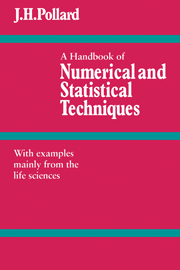Book contents
- Frontmatter
- Contents
- List of statistical and mathematical tables
- Preface
- PART I BASIC NUMERICAL TECHNIQUES
- 1 Introduction
- 2 Errors, mistakes and the arrangement of work
- 3 The real roots of non-linear equations
- 4 Simple methods for smoothing crude data
- 5 The area under a curve
- 6 Finite differences, interpolation and numerical differentiation
- 7 Some other numerical techniques
- PART II BASIC STATISTICAL TECHNIQUES
- PART III THE METHOD OF LEAST SQUARES
- Appendix
- References
- Author index
- Subject index
7 - Some other numerical techniques
Published online by Cambridge University Press: 18 December 2009
- Frontmatter
- Contents
- List of statistical and mathematical tables
- Preface
- PART I BASIC NUMERICAL TECHNIQUES
- 1 Introduction
- 2 Errors, mistakes and the arrangement of work
- 3 The real roots of non-linear equations
- 4 Simple methods for smoothing crude data
- 5 The area under a curve
- 6 Finite differences, interpolation and numerical differentiation
- 7 Some other numerical techniques
- PART II BASIC STATISTICAL TECHNIQUES
- PART III THE METHOD OF LEAST SQUARES
- Appendix
- References
- Author index
- Subject index
Summary
Summary In this chapter we describe a variety of useful numerical techniques. We begin with the problem of regrouping grouped data, and then move on to Hardy's formula, which allows us to estimate the central ordinate of an area. The next important topic is a technique for fusing together two smooth curves to form a single curve. The method of steepest descent for minimising a function of several variables is described in section 7.5; this technique finds applications in many areas, including non-linear least squares (chapter 18). The chapter ends with a simple trick for increasing the data storage capacity of a programmable calculator.
Regrouping grouped data
Data are often grouped. This may be done to produce a concise table or because the data are sparse or some other reason. The user of a particular table may find that the grouping in the table is not suitable and he needs to regroup the data. This can be a very difficult task, particularly when the numbers in certain groups considerably exceed those in neighbouring groups. The best approach is to apply an interpolation method to the cumulative total.
Example 7.1.1. Births to unmarried mothers in Australia in 1968 totalled 18980. The ages of these mothers are shown in table 7.1.1, in broad age groups. Estimate the number of births to unmarried mothers in each of the quinquennial age groups 12–16, 17–21, 22–26, …, 47–51.
- Type
- Chapter
- Information
- A Handbook of Numerical and Statistical TechniquesWith Examples Mainly from the Life Sciences, pp. 60 - 72Publisher: Cambridge University PressPrint publication year: 1977



